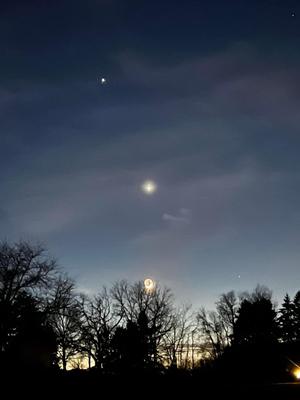Glossarbegriffe: Konjunktion
Description: Aus der Perspektive eines Beobachters auf der Erde spricht man von einer Konjunktion, wenn zwei astronomische Objekte am Himmel scheinbar nahe beieinander zu stehen scheinen. Das heißt: Ihre Himmelskoordinaten unterscheiden sich kaum voneinander.
Die Konjunktion muss nicht tatsächlich sichtbar sein: Mond und Sonne stehen beispielsweise bei Neumond ungefähr auf einer Linie, aber wir können den Mond unter diesen Bedingungen nicht sehen, außer es gibt eine Sonnenfinsternis. In diesem Fall und wenn eine Konjunktion so nahe ist, dass ein Objekt das andere zu verdecken scheint, sprechen Astronomen von einem Transit oder einer Finsternis.
Zugehörige Glossarbegriffe:
See this term in other languages
Term and definition status: The original definition of this term in English have been approved by a research astronomer and a teacher The translation of this term and its definition is still awaiting approval
The OAE Multilingual Glossary is a project of the IAU Office of Astronomy for Education (OAE) in collaboration with the IAU Office of Astronomy Outreach (OAO). The terms and definitions were chosen, written and reviewed by a collective effort from the OAE, the OAE Centers and Nodes, the OAE National Astronomy Education Coordinators (NAECs) and other volunteers. You can find a full list of credits here. All glossary terms and their definitions are released under a Creative Commons CC BY-4.0 license and should be credited to "IAU OAE".
If you notice a factual or translation error in this glossary term or definition then please get in touch.
Zugehörige Medien
Jupiter, Venus, Moon Conjunction
Bildnachweis: Joslynn Appel/IAU OAE (CC BY 4.0)
License: CC-BY-4.0 Creative Commons Namensnennung 4.0 International (CC BY 4.0) icons
Mond-Merkur-Plejaden-Konjunktion
Bildnachweis: Giulio Colombo/ IAU OAE
License: CC-BY-4.0 Creative Commons Namensnennung 4.0 International (CC BY 4.0) icons










